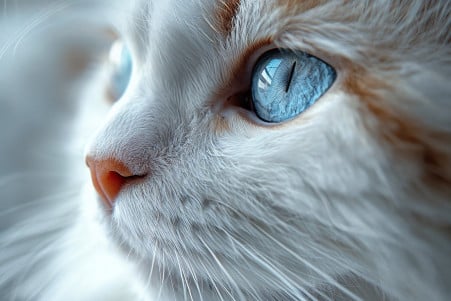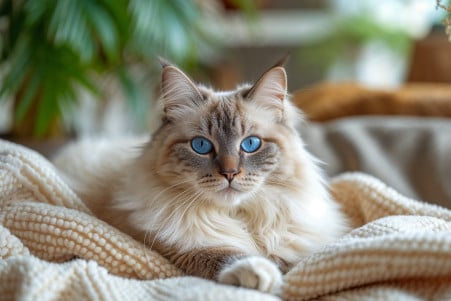Do Cats Have Eyebrows? Understanding Feline Facial Features
26 May 2024 • Updated 25 May 2024

Although cats don't have the bushy eyebrows that humans and some other animals have, they do have bony ridges above their eyes that are similar to eyebrows in both form and function. These ridges are made of cartilage and skin that cover the eye sockets, and they enable cats to squint and widen their eyes in ways that signal different emotions and levels of alertness.
To better understand the biological and evolutionary reasons for these feline "eyebrows," we will look to the field of animal science, which has studied the anatomy and behavior of cats. By drawing on this research, we will learn how cats use these facial features to communicate, express emotions, and survive and thrive in their environments.
Do Cats Have Eyebrows?
The Anatomy and Evolution of Cat 'Eyebrows'
The unique anatomical structures that resemble eyebrows in cats are known as eye ridges. These ridges are composed of cartilage and skin over the eye sockets, along with an intricate network of muscles that allow for a wide range of expressive motions and facial contortions.
As explained in an article by Catster, these "eyebrow whiskers" act as a protective barrier for the cat's eyes, helping to prevent debris or injury by responding to even the smallest particles or movements near the eye area. The whiskers themselves are deeply rooted in the skin, filled with nerve cells and blood vessels that enable them to function as a sophisticated sensory system communicating information to the brain.
These eye ridge structures are believed to have evolved to aid cats in activities like hunting, communication, and environmental adaptation. A study referenced by Science found that the positioning of the ears, whiskers, and eye ridges plays a crucial role in signaling hostile or friendly intent between cats.
While domestic cats share these eye ridge features with their wild feline counterparts like tigers and lions, there are some differences. As the Smithsonian notes, big cats tend to have more pronounced ridges and heavier brow bones that create a perpetual "frown."
Unlike human eyebrows made of fur, a cat's eye ridges serve more of a functional role in expression and protection rather than just an aesthetic one. However, they do allow cats to make recognizable "eyebrow" movements that convey emotions in ways similar to humans, such as raising the ridges to appear inquisitive or furrowing them to seem distrustful or angry.
Understanding Cat Facial Expressions and Body Language
Cats have a wide range of facial expressions and body language that they use to express their emotions and intentions. As explained in Cat Face Expressions 101, cats can recognize and respond to emotional signals in both other cats and humans and will change their behavior based on what they perceive.
For example, a confident, aggressive cat will have a direct hard stare, ears that are upright and facing forward, and pupils that are constricted. On the other hand, a more defensive or insecure cat will have dilated pupils, ears that are flat and facing sideways, and will be slightly turned away from the perceived threat. The Conversation explains that women are better at reading these non-verbal signals in cats.
Friendly, happy cats will have eyes that are open and relaxed, ears that are facing forward, a relaxed mouth, and whiskers that are curved, according to A Guide to a Cat's Facial Expressions. Meanwhile, pain or stress will be shown by squinted eyes, ears that are flat and facing outward, a tense mouth, and whiskers that are pushed forward.
In addition to facial expressions, cats will use their body language, including their tail and overall body position, to communicate how they're feeling. While it can be difficult for humans to pick up on these subtle signals, BBC Newsround explains that cats have almost 300 different facial expressions, which is an impressive amount of communicative ability.
Why Are Cat Whiskers So Important?
Cats use their whiskers as highly sensitive, finely tuned sensory organs. According to Pumpkin, whiskers are long, thick hairs that are deeply embedded in the skin and connected to nerve cells. This makes them highly sensitive to even the slightest changes in the environment, from the lightest breeze to the gentlest touch.
In addition to their sensory functions, the position of a cat's whiskers can also tell you a lot about how they're feeling. For example, according to Four Paws, a cat with their whiskers pressed close to their face is likely feeling scared or anxious, while whiskers that are pushed forward are a sign that a cat is in hunting, playing, or high-alert mode. A cat that's feeling calm and relaxed will have whiskers that are pushed outward and relaxed.
According to Fear Free Happy Homes, cats have three sets of facial whiskers: the eyebrows, the chin, and the longest set on the muzzle. Each set of whiskers can move independently, which means that cats can communicate a wide range of emotions by moving their whiskers in different ways. For example, whiskers that are pressed tightly against the face are a sign of aggression, while a cat that's in pain will have a tense, flat facial expression.
It's important not to cut or overstimulate a cat's whiskers, as PetMD explains. Whiskers are an important part of a cat's anatomy and are responsible for a number of important functions, including sensory perception, navigation, and communication. If these functions are disrupted, it can lead to a cat that's unable to navigate their environment and is in a constant state of stress and discomfort.
Interpreting a Cat's Facial Expressions
While some of the facial expressions cats make may be more obvious, like when a cat is hissing or growling, many of the expressions cats make are quite subtle. As the Williamsburg Veterinary Clinic points out, cats don’t have the same kind of eyebrows as humans, but they do have muscles in their faces that are similar to those that control human eyebrows. This means that cats can make small, nuanced movements that can be read by others as expressions of their emotions.
For example, a cat may furrow their “eyebrows” (i.e., the ridges above their eyes) slightly when they’re feeling tense or worried, or they may raise them to make their expression look more concerned or inquisitive. The Washington Post explains that these small changes are easy for people to miss, but they are important signs of a cat’s internal state.
Being able to recognize these subtle facial expressions is important for understanding a cat’s needs and emotional state, especially when the cat is in a situation where they may feel threatened or anxious. Purina notes that ears that are flattened against the head, a hard stare, and whiskers that are pulled back and tense are all signs that a cat is uncomfortable or may be about to become aggressive. Noticing these subtle changes in a cat’s facial expression can help people who care for cats respond in a way that helps the cat feel safe and secure and that prevents a conflict from occurring.
As we get better at observing and understanding a cat’s facial expressions, even the most subtle ones, we can form stronger bonds with cats, take better care of them, and keep both cats and their human companions safe. This is especially important as we learn more about the cat’s social and emotional lives, which is an area of research that is still in its infancy.
Improving Communication and Relationships With Cats
Learning to recognize the facial expressions, whisker movements, and body language that cats use to express their emotions and intentions can help improve human-cat communication and relationships.
As reported by a study from the CBC, cats can make more than 276 different facial expressions. For example, cats that are feeling friendly and relaxed will have their ears facing forward, their whiskers curved, and their eyes open and relaxed, while cats that are feeling defensive or aggressive will have their ears flattened, their pupils constricted, and their whiskers tense and pushed forward.
The Conversation explains that paying close attention to these subtle changes in a cat's facial expressions as well as their body language, including the position of their tail and their posture, can help pet parents better understand their cats' moods and needs. This can help reduce stress and conflicts and improve the relationship between people and their pets.
Although understanding cats' facial expressions and body language can be difficult, The Washington Post notes that in the future, there may be applications and other resources that can help people interpret cats' facial expressions and body language more accurately. It's also important to remember to respect cats' boundaries and avoid forcing interactions with them, especially when they're showing signs of fear, aggression, or discomfort.
By learning to recognize and interpret the ways cats communicate, we can create an environment that's based on mutual understanding and respect that will help cats live their best lives and bring joy and fulfillment to ours.
Conclusion: Unlocking the Secrets of Feline Communication
The research has revealed the remarkable complexity and diversity of cat facial expressions, which challenge long-held assumptions about their social abilities. Cats use a wide range of facial features, including 'eyebrows', whiskers, and other subtle movements, to communicate their emotions and intentions in intricate ways.
Recognizing and understanding these feline communication signals is crucial for improving human-cat relationships and ensuring proper care. By observing the nuanced shifts in a cat's facial expressions and body language, we can better meet their needs, reduce stress and conflicts, and strengthen the bond between felines and their human companions.
The potential for further research and applications in decoding animal communication is vast, with cats serving as a model for understanding the social and emotional capacities of other species. As we continue to unlock the secrets of feline expression, we encourage readers to observe and appreciate the remarkable diversity of cat facial cues in their daily interactions.


